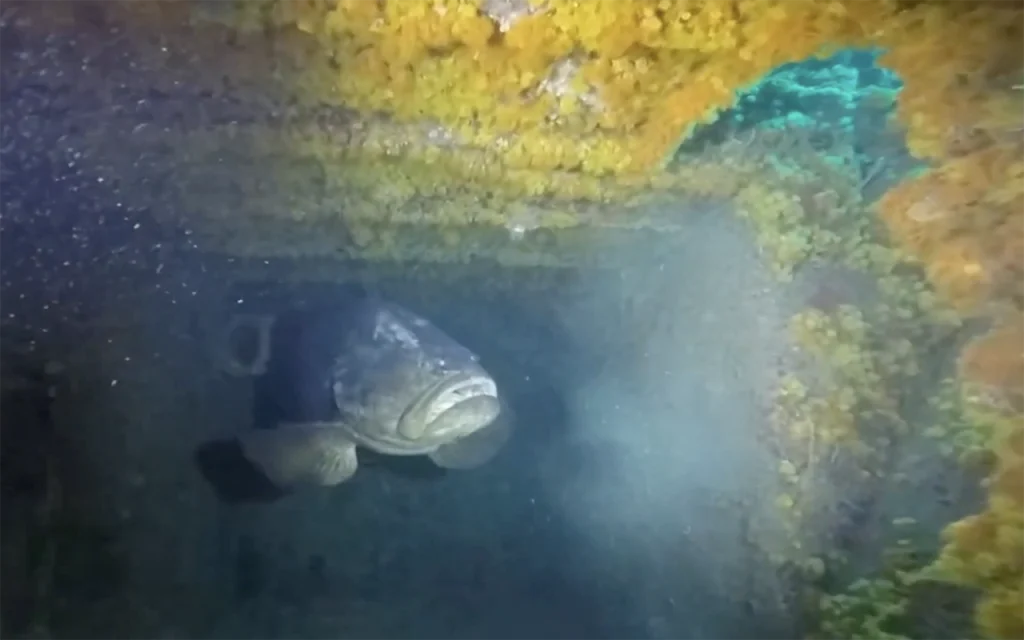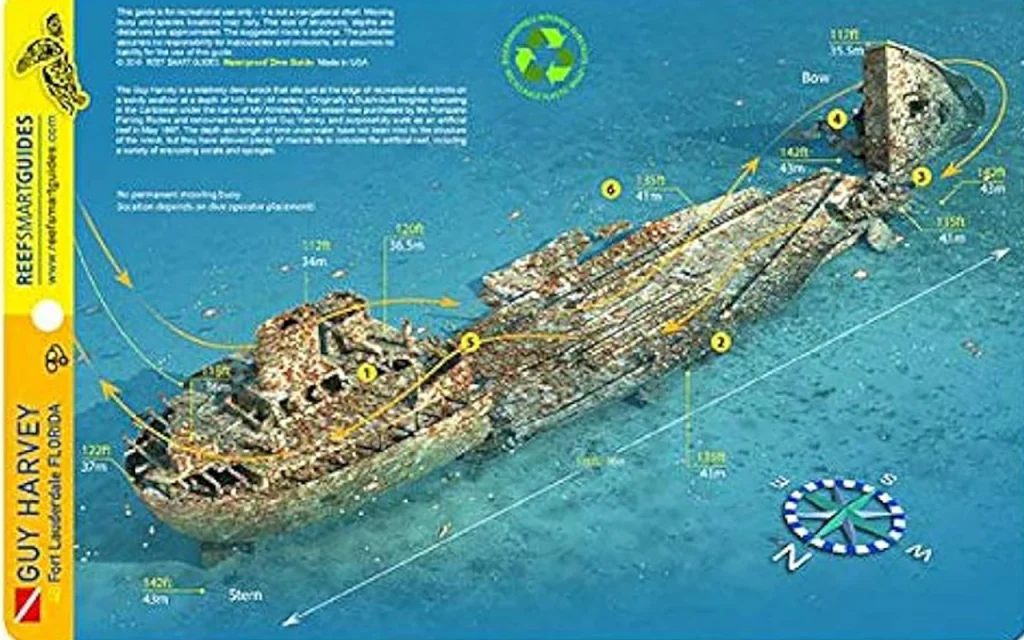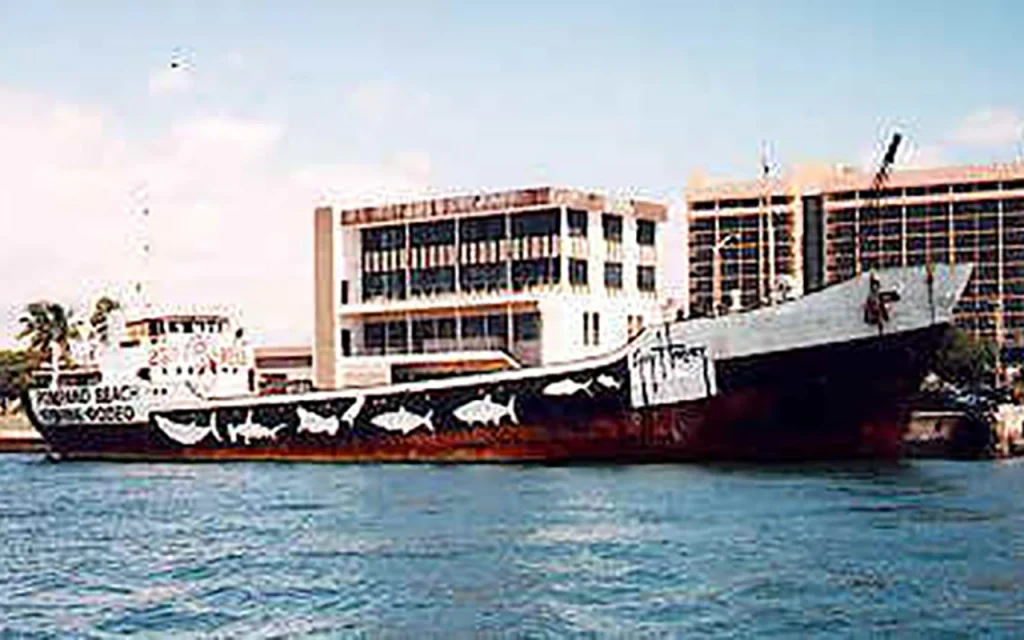Table of Contents

The Guy Harvey wreck is regarded as a worthwhile dive site, offering both challenges and the opportunity to experience a rich underwater environment.
Article at a Glance
- Historical Background: Originally built in 1957 in Holland, the ship served as a coastal freighter before being renamed Lady Kimberly and operating in the Caribbean.
- Purposeful Sinking: The Guy Harvey was intentionally sunk on May 10, 1997, as part of an artificial reef project, financed by renowned marine artist Guy Harvey.
- Artistic Touch: Before its sinking, the ship was adorned with large fish murals painted by Guy Harvey, which have since been mostly covered by marine growth.
- Diving Experience: The wreck lies at an average depth of 108 feet, with its deepest point at 144-145 feet, making it suitable only for experienced and technical divers.
- Marine Biodiversity: The Guy Harvey wreck has developed into a thriving artificial reef, home to various marine life, including barracudas, hogfish, and lobsters.
- Structural Features: The ship remains upright on the seafloor, allowing divers to explore its recognizable features, such as the wheelhouse and deck.
- Safety Considerations: Divers are advised to have advanced training and proper equipment due to the depth and potential currents, ensuring a safe and enjoyable diving experience.
Shipwreck Location Coordinates and Depth
Depth
- The wreck sits in 144-145 feet (43-44 meters) of water at its deepest point.
- The average depth at the site is 108 feet (33 meters).
Location Coordinates
Latitude: 26° 12.647′ N
Longitude: 80° 03.944′ W

What Do Scuba Divers Say About This Ship
General Impressions
- Difficult Dive: Many divers note that the Guy Harvey wreck is considered a challenging dive, suitable only for experienced wreck and technical divers due to its depth, which reaches up to 145 feet (about 44 meters) at its deepest point. The average depth is around 108 feet (33 meters) .
- Marine Life: Divers frequently comment on the vibrant marine life that inhabits the wreck. Species such as barracudas, hogfish, and lobsters are commonly observed, making it an exciting site for underwater photography and marine observation .
Visual Features
- Artistic Elements: The ship was originally painted with large fish murals by renowned artist Guy Harvey, which, although now mostly covered by marine growth, still attract divers for their artistic and historical significance .
- Wreck Structure: The wreck lies upright with the bow facing south, and its structure has developed over time, offering divers a chance to explore both the wreck itself and the surrounding marine ecosystem.
Dive Experience
- Development as an Artificial Reef: As a newer wreck, divers have noted that the Guy Harvey is still in the process of developing as an artificial reef. Initial growth includes soft corals and sponges, which later attract schools of small fish, followed by larger predatory species .
- Diving Conditions: Divers are advised to be prepared for varying conditions, as the wreck is located offshore and can be affected by currents. Proper dive planning and experience are essential for a safe and enjoyable dive .
What Kind of Marine Life Can Be Found on The Ship
Fish Species
- Barracudas: Frequently spotted around the wreck
- Hogfish: Common inhabitants of the shipwreck
- Jacks: Often seen swimming near the structure
- Queen Angelfish: Colorful residents that attract divers’ attention
Invertebrates
- Lobsters: Found making their homes in the wreck’s crevices
- Corals: Both hard and soft corals have colonized the wreck
- Sponges: Various species contribute to the wreck’s ecosystem
- Gorgonians: These soft corals add to the wreck’s underwater landscape
Ecosystem Development
The Guy Harvey wreck has been developing as an artificial reef since its sinking in 1997. The marine life colonization has followed a typical pattern:
- Initial growth of soft corals and sponges
- Attraction of schools of smaller fish seeking shelter
- Arrival of larger predatory fish
Noteworthy Observations
- The wreck is now “completely colonized and covered with corals, sponges, and gorgonians”
- Large fish murals originally painted on the ship have since been covered by marine growth
- The diverse ecosystem attracts various species, creating opportunities for underwater photography and marine observation
Key Information
| Attribute | Details |
|---|---|
| Name | Guy Harvey (formerly Lady Kimberly) |
| Type | Dutch-built coastal freighter |
| Built | 1957 in Holland |
| Length | 185 feet (56 meters) |
| Width | 30 feet (9 meters) |
| Sinking Date | May 10, 1997 (one source mentions May 18) |
| Location | Off Fort Lauderdale, Florida |
| Depth | Average: 108 feet (33 meters) Deepest point: 144-145 feet (43-44 meters) |
| Orientation | Upright with bow facing south |
| Unique Feature | Painted with fish murals by Guy Harvey before sinking |
| Marine Life | Barracudas, hogfish, jacks, Queen Angelfish, lobsters |
| Dive Difficulty | Advanced/Technical dive |
| Suitable For | Experienced wreck divers and technical divers |
| Artificial Reef Status | Completely colonized with corals, sponges, and gorgonians |
What Makes The Guy Harvey Shipwreck a Unique Diving Experience
Artistic Heritage
- Original Murals: The ship was decorated with large fish murals painted by renowned wildlife artist Guy Harvey himself.
- Artistic Evolution: While the white murals were initially visible against the ocean blue, they have since been covered by marine growth, creating an interesting blend of art and nature.
Historical Significance
- Dutch Origins: Built in Holland in 1957, the ship has a rich history.
- Caribbean Service: Spent its last decade sailing between Haiti and the Lesser Antilles as the Lady Kimberly.
- Purposeful Sinking: Sunk on May 10, 1997, as part of an artificial reef project, financed by Guy Harvey and the Pompano Fishing Rodeo.
Diving Challenges
- Deep Dive: Resting at depths between 108-145 feet, it borders on technical diving.
- Experience Required: Suitable only for experienced wreck divers and technical divers due to its depth and conditions.
Marine Ecosystem
- Developing Artificial Reef: As a newer wreck, divers can observe the progression of marine colonization over time.
- Diverse Marine Life: Home to barracudas, hogfish, lobsters, and various coral species.
Structural Features
- Upright Position: The ship sits upright with the bow pointing south, offering an interesting exploration layout.
- Size: Measures 185 feet long and 30 feet wide, providing ample area for exploration.
How Does The Guy Harvey Compare to Other Shipwrecks in Florida
Historical Context
- Recent Sinking: The Guy Harvey was intentionally sunk in 1997, making it much newer than many historic shipwrecks in Florida waters, which often date back to the colonial era or World War II.
- Artificial Reef: Unlike many accidental wrecks, the Guy Harvey was purposefully sunk as part of an artificial reef project, a common practice in more recent times.
Artistic Significance
- Painted Murals: The ship was uniquely decorated with fish murals by renowned marine artist Guy Harvey before sinking, setting it apart from other wrecks.
Depth and Accessibility
- Deep Dive: At 144-145 feet deep, the Guy Harvey is considered a challenging dive, requiring advanced experience. This contrasts with some shallower wrecks that are more accessible to recreational divers.
Marine Life Development
- Evolving Ecosystem: As a relatively new wreck, divers can observe the ongoing process of marine colonization, unlike older wrecks that have established ecosystems.
Comparison to Other Florida Wrecks
- Historical Wrecks: Many Florida shipwrecks, like those from the 1733 Spanish fleet in the Keys, offer glimpses into colonial maritime history.
- Treasure Ships: Unlike famous treasure wrecks like the Atocha, the Guy Harvey doesn’t have a reputation for containing valuable artifacts.
- World War II Wrecks: Florida has numerous WWII-era wrecks, often victims of German U-boat attacks, which offer different historical contexts.
- Artificial Reefs: The Guy Harvey is part of a newer trend of creating artificial reefs, similar to other intentionally sunk ships in Florida waters.
What is The Full History of This Ship
Origins and Early Years
- Built in Holland in 1957
- Originally served as a coastal freighter
- Had multiple owners and names during its first few decades of service
Later Service
- During the 1980s, the ship operated as a freighter between Haiti and the Lesser Antilles
- In its final decade of active service, it sailed under the name Lady Kimberly
Transition to Artificial Reef
- Sold to the Pompano Fishing Rodeo with the intention of creating an artificial reef
- Renamed after Guy Harvey, a renowned Jamaican marine wildlife artist
- Guy Harvey financed the stripping and preparation of the ship for sinking
Preparation and Sinking
- Before sinking, Guy Harvey painted white silhouettes of local fish species on the hull
- The murals were designed to stand out against the ocean blue
- Sunk on May 10, 1997 (one source mentions May 18, but May 10 is cited more frequently)
- Sinking location: 144-145 feet of water off the coast of Fort Lauderdale, Florida
Post-Sinking Development
- Initially, the wreck took time to develop as an artificial reef site
- Over time, it has been colonized by soft corals, sponges, and gorgonians
- The original painted murals have since been covered by marine growth
- Now serves as a habitat for various marine species, including jacks, barracuda, and Queen Angelfish
Current Status
- Lies upright with the bow pointing south
- Rests at an average depth of 108 feet (33 meters), with its deepest point at 144-145 feet (43-44 meters)
- Considered a challenging dive site, suitable for experienced and technical divers
- Has become a popular destination for advanced wreck diving in the Fort Lauderdale area

What Historical Features Can Still Be Identified on the Guy Harvey Wreck
Structural Elements
- Upright Position: The ship sits upright on the seafloor with its bow pointing south, allowing divers to observe its original orientation3.
- Dimensions: The wreck measures 185 feet long and 30 feet wide, maintaining its original size3.
Artistic Remnants
- Fish Murals: Before sinking, Guy Harvey painted large fish murals on the hull and wheelhouse. While these have been largely covered by marine growth, some traces may still be visible in less colonized areas3.
Ship Components
- Wheelhouse: The intact wheelhouse is likely still identifiable, though covered in marine growth1.
- Deck: The ship’s deck structure should be recognizable, providing a surface for coral and marine life growth1.
- Hull: The overall shape of the hull remains, though it’s now colonized by marine organisms13.
Historical Context
- Dutch Origins: While not visually apparent, the ship’s Dutch construction from 1957 is part of its historical significance13.
- Cargo Ship Features: Elements typical of its former life as a freighter may still be identifiable, such as cargo hold areas or remnants of loading equipment1.
Artificial Reef Development
- Marine Growth: The progression of coral, sponge, and other marine life colonization provides a visual timeline of the wreck’s development as an artificial reef since its sinking in 199713.
What Safety Measures Are in Place for Divers Visiting the Guy Harvey
- Diver Experience Requirements:
- The Guy Harvey is only suitable for experienced wreck divers and technical divers.
- Deep diving experience is required due to the wreck’s depth.
- Depth Considerations:
- The wreck sits at an average depth of 33 meters (108 feet), with its deepest point at 43-44 meters (140-145 feet).
- This depth classifies it as a deep dive, bordering on technical diving.
- Dive Planning:
- Proper dive planning is essential due to the depth and potential currents.
- Divers need to calculate air consumption at depth, taking tank pressure and volume into account.
- Equipment Requirements:
- Specialized equipment is necessary for safe exploration, especially for penetration dives.
- An alternate air source, such as a pony bottle or double tanks, is recommended.
- Training:
- Advanced wreck dive training from a certified, qualified dive training professional is necessary, especially for penetration dives.
- Environmental Awareness:
- Divers should be aware of potential currents in the area.
- Visibility can vary, typically ranging from 10-30 meters (33-98 feet).
- Dive Operator Guidance:
- Most dives to the Guy Harvey are likely conducted through experienced dive operators familiar with the site’s conditions and requirements.
- No Solo Diving:
- While not explicitly stated, it’s standard practice to dive with a buddy, especially on challenging sites like this.
- Surface Support:
- As a boat dive, there should be surface support available during the dive.
Dive Shops That Provide Diving Trips to This Shipwreck
- South Florida Diving Headquarters
- This dive shop is mentioned in the search results and provides information about the Guy Harvey wreck on their website.
- Aqua Life Divers
- Located in Pompano Beach, they offer dive trips to various wrecks in the area and have detailed information about the Guy Harvey on their website.
- Parrot Island Scuba
- This dive shop provides information about the Guy Harvey wreck on their website, suggesting they may offer trips to the site.
Central Florida Wrecks
- SS Breconshire
- Georges Valentine
- Hog Heaven
- Urca De Lima
- USS Rankin
- Ana Cecilia
- United Caribbean
- USS Mindanao
- The Laertes
- Berry Patch Tug Wreck
- The Liberty Ship
- The Ana Cecilia
- The Cities Service Empire
- USS Accokeek
- The Tortuga Wreck
- Princess Ann Wreck (Palm Beach)
- Okinawa Wreck (Pompano Beach)
- MG-111 Wreck (Jupiter)
- Lady Luck Wreck (Pompano Beach)
- Rodeo 25 Wreck (Pompano Beach)
- Lowrance Wreck (Pompano Beach)
- RSB-1 Wreck (Deerfield Beach)
- Rebel Wreck (Deerfield Beach)
- Noulla Express Wreck (Fort Lauderdale)
- Sucre Wreck (Fort Lauderdale)
- Captain Tony Wreck (Pompano Beach)
- Peter McAllister Wreck (Pompano Beach)
- Guy Harvey Wreck (Fort Lauderdale)
- Quallman Tugs Wreck (Pompano Beach)
- Miller Lite Wreck (Pompano Beach)





